 This past weekend, we took a trip with some of our friends: Steve and Sue, Jeanne and Paul, and Fred and Mardele to the town of Tequila. Tequila is in Jalisco, about two hours from here. As its name suggests, it is the center of the tequila industry, with the Herradura, Jose Cuervo, and Sauza distilleries all nearby, along with countless other smaller distilleries.
This past weekend, we took a trip with some of our friends: Steve and Sue, Jeanne and Paul, and Fred and Mardele to the town of Tequila. Tequila is in Jalisco, about two hours from here. As its name suggests, it is the center of the tequila industry, with the Herradura, Jose Cuervo, and Sauza distilleries all nearby, along with countless other smaller distilleries.
We chose to tour the Jose Cuervo factory. It's right in town and one of the most esteemed distilleries. Tequila is such a presence in Mexico; I was curious to learn a bit more about the industry and the process of making tequila. As you probably already know, tequila is made from the nectar of the blue agave cactus. Jalisco is the center of the tequila industry, and the vast majority of tequila is made in Jalisco. (The are apparently a few manufacturing facilities in towns neighboring Jalisco, but they have been certified by the Mexican government.) When you drive through the area west of Guadalajara, you see hillsides covered with blue agave plants. It is quite striking.
The first step of the manufacturing process is the cutting of leaves off of the agave plant to expose the head, or core of the plant. Each plant takes about 8 years to mature. Here is a statue of a worker using the traditional method of removing the leaves.
 The shorn heads, or pinas, are then gathered and prepared for baking.
The shorn heads, or pinas, are then gathered and prepared for baking.
 The heads are then baked in an oven for about 36 hours, and squeezed to produce a sweet nectar. It takes approximately 6 pinas to produce one liter of tequila. Here the baked pinas are being conveyed to be squeezed.
The heads are then baked in an oven for about 36 hours, and squeezed to produce a sweet nectar. It takes approximately 6 pinas to produce one liter of tequila. Here the baked pinas are being conveyed to be squeezed.
 Yeast is added to the juice, and the juice is fermented for about several days to produce an alcoholic brew. This is then distilled twice to produce a white tequila which is 55 percent alcohol. This is diluted with water to become "blanco" or clear tequila, the lowest quality tequila. When this is aged in oak barrels (oak from the US or France) for 3-4 months, the tequila takes on an amber color, and is considered "rested" or :reposado." This is a smoother tequila, better for sipping. Tequila that has been aged for a year or more is considered "anejo," the highest grade tequila. We were able to taste all grades including the 5 year anejo, Cuervo "Familia" brand which, until the 1990's was only for the Cuervo family. It was very good, but at $80US a bottle, a bit steep for my tastes. It discovered that I prefer reposado, which is good since it's less than $20 US a bottle. Here are the distilling tanks. (The image is a bit blurry since I could not use a flash, and it was difficult to hald the camera steady enough.)
Yeast is added to the juice, and the juice is fermented for about several days to produce an alcoholic brew. This is then distilled twice to produce a white tequila which is 55 percent alcohol. This is diluted with water to become "blanco" or clear tequila, the lowest quality tequila. When this is aged in oak barrels (oak from the US or France) for 3-4 months, the tequila takes on an amber color, and is considered "rested" or :reposado." This is a smoother tequila, better for sipping. Tequila that has been aged for a year or more is considered "anejo," the highest grade tequila. We were able to taste all grades including the 5 year anejo, Cuervo "Familia" brand which, until the 1990's was only for the Cuervo family. It was very good, but at $80US a bottle, a bit steep for my tastes. It discovered that I prefer reposado, which is good since it's less than $20 US a bottle. Here are the distilling tanks. (The image is a bit blurry since I could not use a flash, and it was difficult to hald the camera steady enough.)
 Here are the oak barrels in which the reposado and anejo are aged:
Here are the oak barrels in which the reposado and anejo are aged:
 We finished the tour of the factory with a tasting where we were taught to appreciate the finer points of tasting tequila. It was fun, although most of us are not going to become regular tequila sippers!
We finished the tour of the factory with a tasting where we were taught to appreciate the finer points of tasting tequila. It was fun, although most of us are not going to become regular tequila sippers!
The young people at the end of the table are university students from Lyon, France who are studying in Morelia. There was a grenade attack during the Independence Day grito in Morelia, President Calderon's hometown, on September 15; seven people were killed. This was a terrible attack by the drug terrorists trying to intimidaete the Mexican government which has been finding and arresting the drug lords. These students reported they were just 50 meters from the blast.
 I was surprised that Tequila was such a small, unsophisticated town. I guess it's my American mindset; I thought that a town with such a tourist gold mine would be more like a theme park. Instead, it's just a moderate-sized town where Mexicans live and work in the tequila industry. Here's a view of the town. The red, white, and green flags in the plaza are left over from Independence Day.
I was surprised that Tequila was such a small, unsophisticated town. I guess it's my American mindset; I thought that a town with such a tourist gold mine would be more like a theme park. Instead, it's just a moderate-sized town where Mexicans live and work in the tequila industry. Here's a view of the town. The red, white, and green flags in the plaza are left over from Independence Day.

On the house front, we are enjoying having our privacy back. However, a new problem has emerged. We have noticed that we are going through our propane quickly (We use this for cooking, hot water, and our dryer, which we hardly use). A tank of gas, which costs about $100 USD should last 3 months; ours is used in a month. We think we have a leak in the line somewhere. Problem is, the lines are all buried within our concrete walls. Hmmmm. We need to contact a plumber, according to the gas guys. We'll see how much of a problem this is!
Here's a poem I wrote which was inspired by the tequila trip:
Tequila
I watch as they squeeze
The baked agave heart
To extract the sweet nectar
Which will become
A fine añejo.
How did the Aztecs discover
The secret of this blue cactus
Which would blunt their senses
Perhaps, and make sense
Of their blood sacrifice?
For this tequila is
The story of all
The beauty and the tragedy.
For as the blue agave spreads
Upon the hills of Jalisco
Stunning against the crimson sun,
And reliably generates wealth
To a lucky few,
Always the same few
Who squeeze the labor
From the brown bodies
As they squeeze the juice
From the cactus.
And it is this same spirit
Which has nourished the
Bloody violence of the Revolution
And naked exploitation
Which has burned a hole
Into the Mexican soul.
I stopped my car
In the hot sun
One morning
By a group
Of dark-skinned, unshaven men
To ask directions.
They staggered and slurred
And offered me
A bit of their tequila
And I tried
But could not see
Through their glassy eyes
Into their pain.
And I think of those men
And gaze at the beautiful garden
As I sip my reposado
And remember to remember
How I have been lucky
To have been born
On the right side
Of this beautiful blue agave.
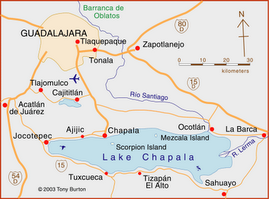




















































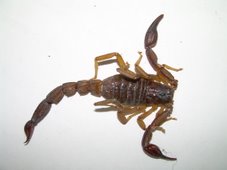

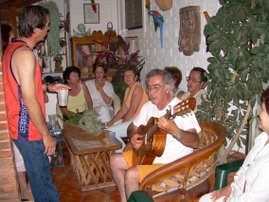






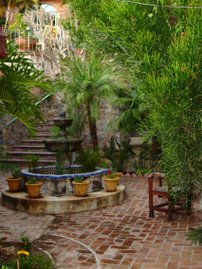
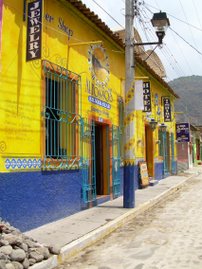
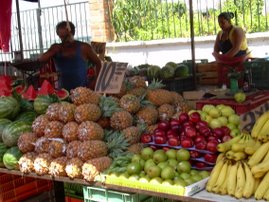


1 comment:
Wow, Bill. I was personally moved by the poem. A rainy day in Rhode Island, Jim
Post a Comment